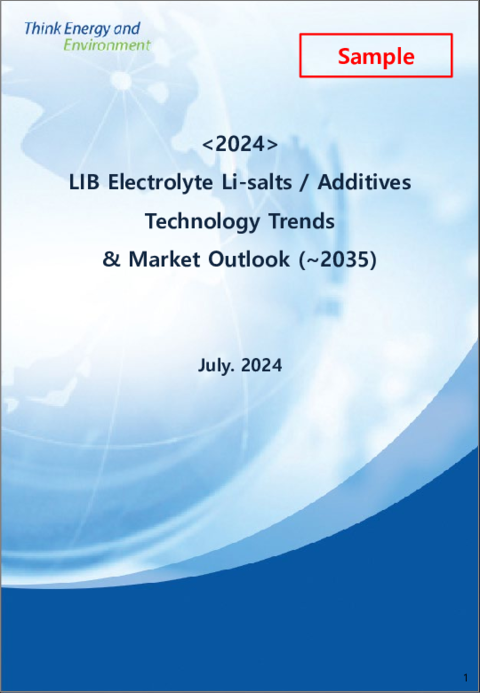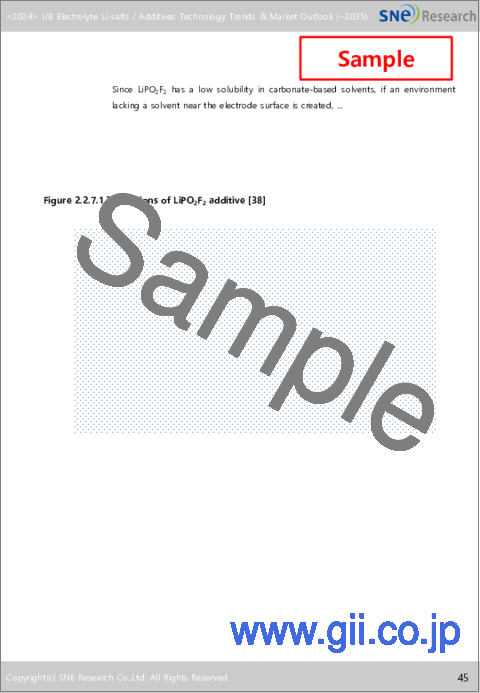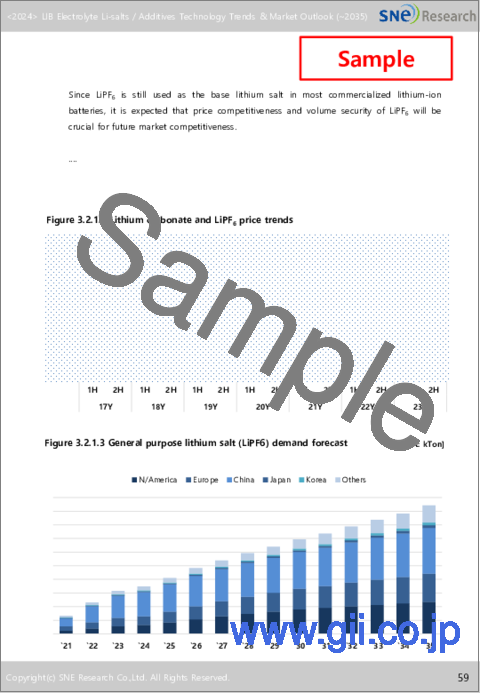|
|
市場調査レポート
商品コード
1526416
LIB電解液用リチウム塩・添加剤の技術動向と市場見通し<2024> LIB Electrolyte Li-salts, Additives Technology Trends & Market Outlook |
||||||
|
|||||||
| LIB電解液用リチウム塩・添加剤の技術動向と市場見通し |
|
出版日: 2024年07月29日
発行: SNE Research
ページ情報: 英文 292 Pages
納期: お問合せ
|
全表示
- 概要
- 目次
電解液はリチウムイオン二次電池の4大材料の1つです。主に溶媒、リチウム塩、添加剤で構成されます。
一般に、リチウムイオン二次電池の有機電解液に求められる重要な特性は、リチウムイオン伝導性と電気化学的安定性です。したがって、使用する電極にかかわらず、優れた電池性能を確保するためには、リチウムイオンの移動性に優れ、電池の動作電位範囲内で深刻な電気化学的分解反応を起こさない電解液を使用する必要があります。
リチウムイオン二次電池では、リチウム塩が電解液の主成分であり、電池の性能と安定性を決定する重要な役割を担っています。リチウム塩はリチウムイオンの伝導性を確保し、電池内で電荷を効果的に移動させる媒体として機能します。代表的なリチウム塩には、ヘキサフルオロリン酸リチウム(LiPF6)、トリフルオロメタンスルホン酸リチウム(LiTFSI)、リチウムビス(フルオロスルホニル)イミド(LiFSI)などがあります。LiPF6は高い伝導性と低温での安定性から広く用いられていますが、高温での熱不安定性や加水分解による副作用が問題点として指摘されています。
これに代わるものとして、伝導性と熱安定性に優れたLiFSIなどのリチウム塩が研究されています。特にLiFSIはLiPF6よりも優れた化学的・熱的安定性を示し、高いイオン伝導性と低い電気抵抗が特徴です。また、LiFSIは低粘度で電気化学的安定性に優れ、電池の寿命や安全性の向上に寄与します。しかし、製造コストや腐食性などのデメリットもあるため、適切な組み合わせが電池の性能と安全性を向上させる鍵となります。
添加剤は、リチウムイオン二次電池の電解液の性能向上に重要な役割を果たしています。添加剤は主に電解液の安定性、伝導性、界面特性を向上させるために使用されます。例えば、固体電解液界面(SEI)の形成を促進する添加剤は、電池の寿命と安定性の向上に寄与します。代表的な添加剤にはフルオロエチレンカーボネート(FEC)やビニレンカーボネート(VC)があり、これらはSEI層を形成して負極の安定性を高めます。また、硫化物系添加剤は正極の安定性を向上させ、高電圧での性能を高める。
近年の研究でさまざまな新しい添加剤が開発されており、それらの組み合わせによって電池性能を最適化する活動がなされています。例えば、LiFSIとともに使用される特定の添加剤は、電解液の電位窓を広げ、高いエネルギー密度を維持しながらサイクル寿命を延ばすことができます。これらの添加剤との相乗効果は、エネルギー密度、サイクル寿命、安全性など、リチウムイオン二次電池のさまざまな性能指標を向上させる重要な要素です。LiFSIと添加剤の革新的な組み合わせは、次世代の高性能リチウムイオン二次電池の実用化を加速する上で重要な役割を果たします。
電解液で重要な役割を果たすリチウム塩や添加剤は、従来は日本企業からの供給が中心でしたが、中国企業が生産能力を大幅に拡大したことで、様相が変わってきました。もっとも一般的に使用されている汎用リチウム塩であるLiPF6の場合、かつては日本のStella Chemifa、Morita、Kanto Denka、韓国のHoosungなど数社しか電池品質の製品を供給できませんでしたが、リチウム塩技術の発展と生産能力の拡大により、現在ではTinci MaterialsやDFDなどの大企業が絶対的な強者となっています。また、特殊リチウム塩(LiFSIなど)や添加剤では、日本ではMitsubishi Chemical、Central Glass、Nippon Shokubaiなど独自特許を持つ企業が市場をほぼ独占していましたが、現在では韓国のCheonbo、中国のHSC、Genyuanなどがバイパス特許や独自技術でシェアを伸ばし続けています。
当レポートでは、LIB電解液市場について調査分析し、リチウム塩・添加剤の主な特徴と用途に関する詳細な技術情報や、供給状況、市場見通し、主要メーカーの製品と生産状況などの情報を提供しています。
目次
第1章 概要
- 背景
- 電解液の概要
- 電解液の成分と特性
第2章 リチウム塩/添加剤の開発動向
- リチウム塩の開発動向
- リチウム塩の概要
- 機能と特徴:リチウム塩タイプ別
- 添加剤開発動向
- 高電圧負極酸化皮膜形成用添加剤
- 低電圧負極酸化皮膜形成用添加剤
- 還元分解型化合物による負極SEIの形成プロセス
- 構造的に破壊されたSEI層を再生する機能性添加剤
- 電池の性能劣化の原因となる反応性化合物を除去する添加剤
- 高Ni系正極界面安定化向け電解液添加剤
- 出力特性を向上させる電解液添加剤
- LiFSI塩を使用した電解液
- 熱安定性を向上させる難燃添加剤
- 高容量負極の界面安定化向け添加剤
- Niリッチ高電圧システム添加剤(SiOxあり/なし)
- シリコン負極用添加剤
- LFP正極用添加剤
- LMFP正極用添加剤
- HF、LFP・LMFP正極用金属捕捉機能添加剤
- LMR正極用添加剤
- 安全向け添加剤
- リチウム塩と添加剤の合成機構に関する研究
- F電解液(LiFSI)
- VC(ビニレンカーボネート合成)添加剤
- VC(ビニレンカーボネート合成)添加剤
- VEC(ビニルエチレンカーボネート)添加剤
- 全固体電池用添加剤
- 全固体電池の必要性
- 全固体電池の問題
- 固体電解液向けソリューション
- 全固体電池の開発(正極・負極の表面改質)
- 全固体電池の寿命向上に関する研究
- 全固体電池ベンダーによる開発
第3章 リチウム塩/添加剤市場の動向と予測
- LIB電解液市場の背景
- 下流予測
- 需給の予測
- 電解液コンポーネント材料予測
- コスト構造
- リチウム塩/添加剤市場の現状と予測
- 汎用リチウム塩(LiPF6)
- 特殊リチウム塩
- 電解液添加剤
Electrolyte is one of the 4 major materials of lithium-ion secondary batteries. It is largely composed of solvents, lithium salts, and additives.
In general, the important characteristics required for organic electrolytes for lithium-ion secondary batteries are lithium-ion conductivity and electrochemical stability. Therefore, regardless of the electrode used, an electrolyte with excellent lithium-ion mobility and no serious electrochemical decomposition reaction within the battery operating potential range must be used to secure excellent battery performance.
In lithium-ion secondary batteries, lithium salts are the main components of the electrolyte and play an important role in determining the performance and stability of the battery. Lithium salts secure the conductivity of lithium ions and act as a medium that effectively transfers charges within the battery. Representative lithium salts include lithium hexafluorophosphate (LiPF6), lithium trifluoromethanesulfonate (LiTFSI), and lithium bis(fluorosulfonyl)imide (LiFSI). LiPF6 is widely used due to its high conductivity and stability at low temperatures, but its thermal instability at high temperatures and side effects due to hydrolysis are pointed out as problems.
As an alternative, lithium salts such as LiFSI are being studied, which offer excellent conductivity and thermal stability. LiFSI shows particularly superior chemical and thermal stability than LiPF6, and is characterized by high ionic conductivity and low electrical resistance. In addition, LiFSI provides low viscosity and excellent electrochemical stability, contributing to improving the lifespan and safety of batteries. However, it also has disadvantages such as manufacturing cost and corrosiveness, so an appropriate combination is the key to improving battery performance and safety.
Additives play an important role in improving the performance of electrolytes in lithium-ion secondary batteries. Additives are mainly used to improve the stability, conductivity, and interfacial properties of electrolytes. For example, additives that promote the formation of a solid electrolyte interphase (SEI) contribute to improving the life and stability of the battery. Representative additives include fluoroethylene carbonate (FEC) and vinylene carbonate (VC), which form an SEI layer to enhance the stability of the anode. In addition, sulfide-based additives improve the stability of the cathode, thereby enhancing performance at high voltages.
Recent studies have been developing various new additives, and efforts are being made to optimize battery performance through their combination. For example, certain additives used with LiFSI can widen the electrochemical window of the electrolyte and extend the cycle life while maintaining high energy density. The synergy with these additives is a key factor in improving various performance indicators of lithium-ion secondary batteries, such as energy density, cycle life, and safety. The innovative combination of LiFSI and additives will play an important role in accelerating the commercialization of next-generation high-performance lithium-ion secondary batteries.
Lithium salts and additives, which play a key role in electrolytes, were mostly supplied by Japanese companies in the past, but the landscape has changed as Chinese companies have significantly expanded their production capacity. In the case of LiPF6, the most commonly used general-purpose lithium salt, only a few companies, including Stella Chemifa, Morita, and Kanto Denka in Japan and Hoosung in Korea, could supply battery-quality products in the past, but in the past, large companies such as Tinci Materials and DFD have become absolute powerhouses in the current market through the development of lithium salt technology and expansion of production capacity. In the case of special lithium salts (such as LiFSI) and additives, companies that held original patents, such as Mitsubishi Chemical, Central Glass, and Nippon Shokubai in Japan, almost monopolized the market, but currently, Cheonbo in Korea and HSC and Genyuan in China are continuously increasing their market share based on bypass patents or their own technologies.
In this report, we have organized in detail the technical information on lithium salts and additives, which are the most essential components of lithium-ion secondary battery electrolytes, and have provided a multi-faceted outlook on the market for lithium salts and additives based on our various outlook data to help readers understand the overall market situation.
Finally, we have tried to provide researchers and interested parties in this field with a wide range of insights from technology to market by summarizing the business status and future plans of major lithium salt and additive manufacturers.
Strong points of this report:
- 1. Includes detailed technical information on the main characteristics and applications of lithium salts and additives
- 2. Provides objective data through market outlook based on our forecast and various data
- 3. Understands the main supply status and outlook of the lithium salt and additives market
- 4. Includes detailed information on the products and production status of major players in Korea, China, and Japan
Table of Contents
Chapter I. Overview
- 1.1. Background
- 1.2. Electrolyte Overview
- 1.3. Electrolyte components and properties
Chapter II. Li-Salts / Additives Development Trends
- 2.1. Lithium Salt Development Trends
- 2.1.1. Lithium Salts Overview
- 2.1.2. Functions and features for each lithium salt type
- 2.2. Additives Development Trends
- 2.2.1. Additives for high voltage anodic film formation
- 2.2.2. Additives for low voltage anodic film formation
- 2.2.3. Process of forming the anode SEI by reductive-decomposing-type compounds
- 2.2.4. Functional additive to regenerate the structurally destroyed SEI layer
- 2.2.5. Reactive compound-removing additive that causes performance deterioration of batteries
- 2.2.6. Electrolyte additives for high-Ni-based cathode interfacial stabilization
- 2.2.7. Electrolyte additives for improved output characteristics
- 2.2.8. Electrolytes using LiFSI salt
- 2.2.9. Flame retardant additives to improve thermal stability
- 2.2.10. Additives for interfacial stabilization of high-capacity anodes
- 2.2.11. Ni-rich and high voltage system additives (w/ or w/o SiOx)
- 2.2.12. Additives for silicon anodes
- 2.2.13. Additives for LFP cathodes
- 2.2.14. Additives for LMFP cathodes
- 2.2.15. HF, Metal scavenger functional additives for LFP & LMFP cathodes
- 2.2.16. Additives for LMR cathodes
- 2.2.17. Additives for safety
- 2.3. Study on Lithium Salt and Additive Synthesis Mechanisms
- 2.3.1. F Electrolyte(LiFSI)
- 2.3.2. VC (Vinylene Carbonate Synthesis) additives
- 2.3.3. VC (Vinylene Carbonate Synthesis) additives
- 2.3.4. VEC (Vinylethylene Carbonate) additives
- 2.4. All-Solid-State Battery Additives
- 2.4.1. The need for all-solid-state batteries
- 2.4.2. All-solid-state battery issue
- 2.4.3. Solutions for solid electrolytes
- 2.4.4. All-solid-state cell battery development (surface modification of cathode, anode)
- 2.4.5. Research on improving the lifetime of all-solid-state batteries
- 2.4.6. Developments by all-solid-state battery vendor
Chapter III. Lithium Salt/Additives Market Trends and Forecasts
- 3.1. LIB Electrolyte Market Background
- 3.1.1. Downstream Forecast
- 3.1.2. Supply and Demand Forecast
- 3.1.3. Electrolyte Component Material Forecast
- 3.1.4. Cost Structure
- 3.2. Lithium Salts/Additives Market Status and Forecast
- 3.2.1. General-purpose lithium salts (LiPF6)
- 3.2.2. Specialty lithium salts
- 3.2.3. Electrolyte additives






